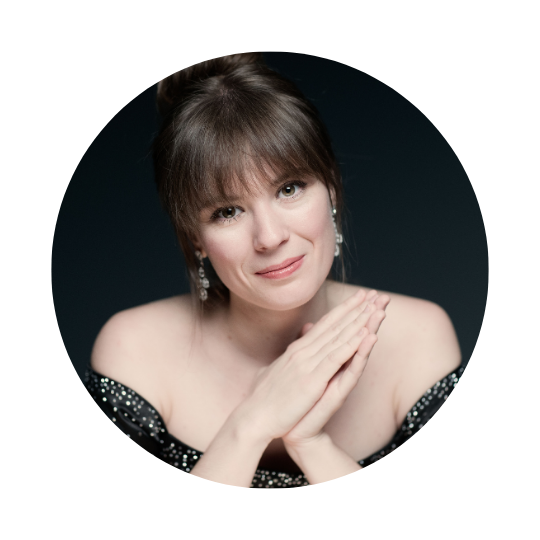BEETHOVEN 5
Rossen Milanov, conductor
Anna Federova, piano
This concert is presented in memory of Thomas & Georgianna Cochran and Marvin & Barbara Easter, by Robert & Susan Easter Cochran.
| • • • • • • • • • • • • • • • • • • • • • • • • • • • • • • | ||
| Beethoven | Concerto No. 5 in E-flat Major for Piano and Orchestra, Op. 73 (“Emperor”) | |
| Anna Fedorova, piano | ||
INTERMISSION | ||
| Beethoven | Symphony No. 5 in C Minor, Op. 67 | |
Anna Fedorova

Anna Fedorova’s playing is “unfailingly sensitive, poetic and tasteful, the phrases flexibly shapeeven when the technical going gets tough (...) she never forces her tone and never loses her cool” (Gramophone).
From an early age, the Ukrainian-born pianist Anna Fedorova showed an innate musical maturity and amazing technical abilities. Her live recording of Rachmaninoff’s 2nd Piano Concerto has more than 43 million views on YouTube and is highly acclaimed by critics and world-renowned musicians. She regularly performs at the world’s most prestigious concert halls such as the Concertgebouw Amsterdam, New York’s Carnegie Hall, Auditorium Nacional de Madrid, Palacio de Bellas Artes in Mexico City, London’s Barbican Centre & Royal Albert Hall, Tonhalle Zürich, Théâtre des Champs-Elysées, Bunka Kaikan in Tokyo, and many others.
Called the ‘house pianist’ of the Concertgebouw, Anna Fedorova has performed there more than 30 times as well as in numerous online and television broadcasts. In 2025 Anna performs the Tchaikovsky concerto no.1 in Bangkok and in Metz; Ravel concerto in G in the Auditorium Madrid and Gershwin “Rhapsody in Blue” in Lodz (Poland); Rachmaninoff Concerto no. 2 in Mexico, Athens and in Norway; Schumann in Modena (Italy) and Beethoven Concerto no. 5 in Columbus.
Anna Fedorova performed with the Verbier Festival Orchestra under the baton of Gianandrea Noseda at the opening of the festival in 2022. One week later, she made her debut at the International Piano Festival La Roque-d’Anthéron with a solo recital. That summer she also went on tour with the Ukrainian Freedom Orchestra. The New York Times noted that “pianist Anna Fedorova was a sensitive, poetic soloist in Chopin’s Piano Concerto No. 2, a nod to the Polish support for the Freedom Orchestra project.” The late Menahem Pressler wrote about her BBC Proms debut with the orchestra at the Royal Albert Hall: “Anna Fedorova’s beautiful sound and natural freedom in making music with total technical security makes for one of the finest Chopin performances I have heard in a long, long time”.
In the fall of 2024, Anna Fedorova presented her new CD Intrigues of the Darkness. Anna is an exclusive Channel Classics/Outhere Music artist. She has released three solo piano albums, four chamber music albums, and all of Rachmaninoff’s Piano Concertos with the Sinfonieorchester St. Gallen. BBC Music Magazine gave a 5+5 star-review for the first album. The most recent chamber music album was “Fathers and Daughters” featuring Anna and Dana Zemtsov and their fathers.
Anna Fedorova graduated from the Lysenko School of Music in Kyiv with Borys Fedorov and the Accademia Pianistica in Imola, Italy, with Leonid Margarius. She received her Master’s degree and Artist Diploma at the Royal College of Music, London, under the guidance of Norma Fisher. Her mentors include Alfred Brendel, Menahem Pressler, Steven Isserlis, and sir András Schiff.
In 2022, Anna Fedorova and double bassist Nicholas Santangelo Schwartz founded the Davidsbündler Music Academy in The Hague. Before the Academy’s door officially opened in September 2022, the Davidsbündler Foundation already started to provide top quality musical education to Ukrainian refugees who have fled to the Netherlands.
Piano Concerto No. 5 in E-flat major, Op. 73 (1809)
Ludwig van Beethoven (Bonn, 1770 - Vienna, 1827)
There are many reasons why music lovers can never seem to get enough of Beethoven. He found ways for music to communicate feelings at an unprecedented level of intensity. The question about the “meaning of music” received new relevance in his works because listeners felt from the start that his radical innovations were motivated by the need to say things that had never been said before.
Beethoven’s oeuvre is habitually divided into early, middle and late periods, and it is during the decisive middle years (also known as the “heroic” period) that he wrote the two iconic works heard at tonight’s concert. The two “Fifths” (the Piano Concerto in E-flat major and the Symphony in C minor) show a side of the composer that has been more influential than any other. Both works project a sense of majestic grandeur and a struggle with adversity that ends in triumph. Beethoven’s unshakable belief that difficulties can be overcome, darkness can be dispelled by light, and all conflicts may be resolved in harmony, is an eternal source of inspiration that we need today more than ever.
One of the most grandiose monuments of Beethoven’s musical heroism is his fifth and final piano concerto, known in English-speaking countries as the “Emperor.” The nickname seems appropriate even if it was not given by the composer himself. There are several stories about its origin; according to one, a French soldier from Napoleon’s army occupying Vienna jumped to his feet after hearing the work and exclaimed: “L’empereur!” He may have been impressed by the concerto’s majestic proportions, or else he was reminded of French revolutionary marches by certain themes in the work. In either case, he was right on target, as a soldier should be.
In an influential study published in the 1950s, musicologist Alfred Einstein examined what he called “Beethoven’s Military Style.” Einstein showed that Beethoven had adopted this manner from Giovanni Battista Viotti, a Parisian composer of Italian birth (1755-1824), known mainly for his violin concertos.
One may characterize [the military style] as an idealized quickstep: rapid four-four time, progressing boldly with growing intensity, with dotted eighth-notes and up-beat patterns, with ever-pulsating rhythm–although above this rhythm some cantabile, “feminine” melodies hover, and triplets and virtuoso figurations soar upward.
This description fits the main theme of the “Emperor” Concerto’s first movement to a t. It appears after a most extraordinary opening, in which a brilliant piano cadenza (not to be improvised but fully written out) is punctuated by orchestral chords that outline the most familiar of all harmonic progressions (‟one-four-five-one”). The orchestral exposition that follows abounds in “military” dotted-eighth patterns. Yet later on, the themes take on a softer, more lyrical character. A second theme, originally all rhythm and angularity, is transformed into a continuous, smooth eighth-note motion played in the piano’s highest register and in a distant tonality. It is a moment of great mystery, cut short by an abrupt return to the initial form of the theme.
The piano writing is more brilliant that in any of the earlier concertos; it includes, in the development section alone, virtuosic sixteenth-note passages in both hands simultaneously, dashing octave runs, and expressive melodic motifs, often in very close succession. The recapitulation, which begins with a somewhat shorter replay of the opening piano cadenza, has another, even more stunning, cadenza-like passage at the end. Yet although it is introduced by the powerful chord (the so-called “six-four”) that always precedes cadenzas, what we hear is not an ad-libitum interpolation that can be freely added by the performer. This becomes clear as soon as two horns quietly join the piano, and other instruments follow a little later. In fact, Beethoven’s instruction in the score, written in Italian, the international language of music at the time, reads: Non si fa una Cadenza, ma s’attacca subito il seguente (“Don’t play a cadenza; instead, proceed directly with the following”). In this work, Beethoven assumed such total control over every aspect of the composition that it became impossible to leave anything to chance. (Also, this was his only piano concerto that he was unable to perform himself because of his deafness, and apparently, he didn’t trust his pupil Carl Czerny enough to let him improvise his own cadenza.) However, this non-cadenza does fulfill the formal function of the traditional cadenza; it allows the performer to display her or his technical prowess, in a bravura section built upon some of the movement’s most important themes.
The second movement opens with a chorale-like melody played by muted strings; the tonality is a distant B major—a key that has already been touched upon in the first movement. The piano responds to the chorale with an expressive second theme that moves faster than the orchestra’s chorale. The two motions are then combined as the chorale melody is taken over by the piano, its slow quarter-notes accompanied by the faster triplets derived from the second theme. After a further variation where the motion intensifies, the music comes to a halt on the note B. Beethoven simply lowers this note by a half-step to B flat, to prepare the return of E-flat major in the last movement.
There is no pause between the second and third movements; in fact, the continuity is assured through the appearance of the finale theme in a slow tempo at the end of the second movement, played haltingly. It is another gesture that mimics improvisation: it sounds as if the pianist were experimenting with a melody and finally “discovering” the rondo theme, which then bursts forth, full of energy.
In a Mozart or early Beethoven rondo, the character of this theme would remain the same throughout; here, however, the exuberant melody becomes more subdued in the course of the movement and touches on many distant keys before returning in its original form. The penultimate moment is particularly memorable for a suspenseful duo between the solo piano and the solo timpani. This surprising episode is followed by only a few brief measures to conclude this incomparable concerto.
Symphony No. 5 in C minor, Op. 67 (1808)
“The reviewer has before him one of the most important works by the master whose pre-eminence as an instrumental composer it is doubtful that anybody would now dispute.” These words were written by E.T.A. Hoffmann (1776-1822), the prominent German writer and composer, in 1810, a year and a half after the first performance (which he had not heard), in a review of the score of Beethoven’s Fifth Symphony. Although writings about this work would now fill a small library, few authors in the past 215 years have equalled Hoffmann’s sensitivity, and his ability to combine a poet’s imagination with the thoroughness of a musical scholar.
Hoffmann immediately understood the significance of the symphony's opening motif, the famous ta-ta-ta-TA: “Nothing could be simpler than the main idea of the opening Allegro, consisting of only two bars and initially in unison, so that the listener is not even certain of the key. The mood of the anxious, restless yearning created by this subject is heightened even further by the melodious secondary theme.” The fermata, the long-held note at the end of the first extended phrase, gives, according to Hoffmann, “presentiments of unknown mysteries.”
Everything in the first movement—indeed, a great many things in the whole symphony—are, one way or another, derived from that opening ta-ta-ta-TA. The rhythm is almost always present in the bass or in the treble, in its original form or with modifications. Whether or not this theme represents “Fate knocking on the door,” as Beethoven is supposed to have claimed, the dramatic tension of the music and the heroic struggle it portrays are obvious. Beethoven might well have called this symphony an “Eroica,” had he not used that name earlier for his Third Symphony.
In the second-movement Andante con moto, two themes alternate in a kind of “double variation” form. A gentle opening melody is followed by loud military fanfares, and the movement is based largely on the transitions back and forth between these two kinds of material. In the course of the variations, the character of the first theme changes from lyrical to mysterious.
The mood becomes dark again in the third-movement Allegro. Beethoven did not use the title “Scherzo,” although it is obviously one of the fast movements in 3/4 time with a contrasting middle section that he elsewhere called “scherzi” (jokes). This time, however, we feel a chilly wind blowing as the cellos and double basses begin the pianissimo theme of the movement. Soon a variant of the first movement's ta-ta-ta-TA motif appears on the horns; it sounds even more austere now that all four notes have the same pitch (that is, the last note does not drop a third as it did in the first movement). The Trio, which starts out as a fugue with an agile theme played by the cellos and double basses, provides some comic relief for a moment, but then a most extraordinary thing happens. The theme of the first section returns, but the strings play pizzicato (with plucked strings) and the legato (continuous) melody is broken up into mysterious-sounding staccato (separated) notes. If the first version of the theme made a chilly impression, this time it is definitely freezing, and the recapitulation is followed by a section characterized by the deepest despair music has ever expressed. We hear a pianissimo kettledrum solo over the long-held notes of the strings; against this thumping background, a violin theme (related to the first theme of the movement) gradually emerges and rises higher and higher against the insistent ostinato in basses and timpani. In one of the most stunning “darkness-to-light” transitions in the orchestral literature, we reach, after 50 measures of suspense and a powerful crescendo, the glorious Allegro in C major which proclaims the victory at the end of a long battle.
Piccolo, contrabassoon, and three trombones (instruments Beethoven had never used in his first four symphonies) join the orchestra for this exuberant celebration, in a movement in which the various themes follow one another with a naturalness and inevitability that is one of the greatest miracles of Beethoven’s music. The movement follows the traditional sonata pattern of exposition, development, and recapitulation, but between the last two, another surprise awaits us. (It is another miracle that after a thousand hearings, it still comes as a surprise.) The last section of the third movement returns, and the transition from darkness to light in enacted all over again. However, nothing is repeated literally; the orchestration is new, made less gloomy by the more melodic woodwind parts. The transition itself is new, the “chilly” string melody is totally absent, and we reach the triumphant Allegro much faster and more easily than the first time. Donald Francis Tovey, the celebrated British musical analyst, wrote eloquently about the effect of this passage:
Beethoven recalls the third movement as a memory which we know for a fact but can no longer understand: there is now a note of self-pity, for which we had no leisure when the terror was upon our souls: the depth and the darkness are alike absent, and in the dry light of the day we cannot remember our fears of the unknown. And so the triumph resumes its progress and enlarges its range until it reaches its appointed end.
That appointed end, the “Presto” Coda with its 54 measures of C-major chords, has raised, we must say, a few eyebrows. Even Hoffmann felt this was too much of a good thing: the final C-major strokes, separated by rests, reminded him of “a fire that is thought to have been put out but repeatedly bursts forth again in bright tongues of flame.” Yet it seems that a shorter coda would not have been enough to balance out the enormous tensions of the symphony. Like an airplane that, after landing, taxis on the ground for a long time before coming to a complete stop, Beethoven's Fifth ends gradually; after the thematic material has disappeared, the music still continues with a bare restatement of the C-major tonality. Finally, even the C-major chord goes away, replaced by a single unison C that marks the final arrival.
Notes by Peter Laki



